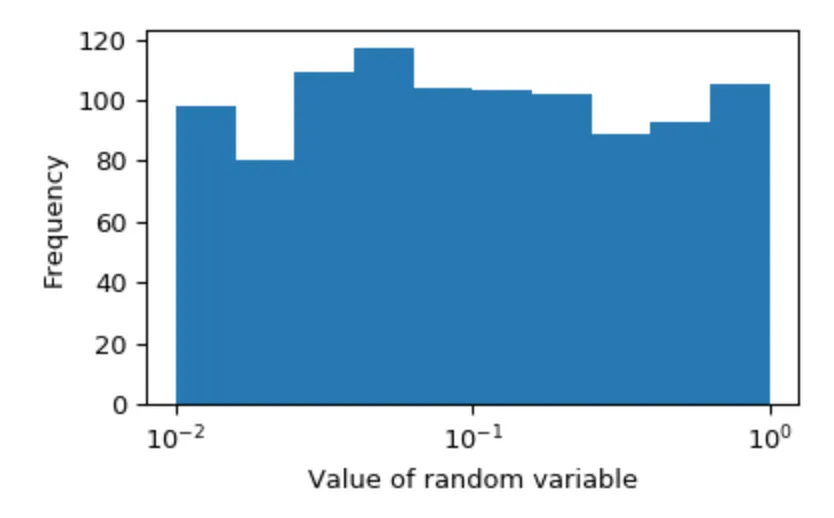在Python中,我找不到一个内置的函数来生成一个对数均匀分布,给定一个最小值和最大值(R语言的等效函数在这里),类似于: loguni[n, exp(min), exp(max), base],返回范围在exp(min)和exp(max)之间的n个对数均匀分布。
然而最接近的是numpy.random.uniform函数。
在Python中,我找不到一个内置的函数来生成一个对数均匀分布,给定一个最小值和最大值(R语言的等效函数在这里),类似于: loguni[n, exp(min), exp(max), base],返回范围在exp(min)和exp(max)之间的n个对数均匀分布。
然而最接近的是numpy.random.uniform函数。
来自http://ecolego.facilia.se/ecolego/show/Log-Uniform%20Distribution:
在对数均匀分布中,假设对数转换后的随机变量是均匀分布的。
因此
logU(a, b) ~ exp(U(log(a), log(b))
因此,我们可以使用numpy创建对数均匀分布:
def loguniform(low=0, high=1, size=None):
return np.exp(np.random.uniform(low, high, size))
如果您想选择不同的基数,我们可以定义一个新函数如下:
def lognuniform(low=0, high=1, size=None, base=np.e):
return np.power(base, np.random.uniform(low, high, size))
编辑: @joaoFaria的回答也是正确的。
def loguniform(low=0, high=1, size=None):
return scipy.stats.reciprocal(np.exp(low), np.exp(high)).rvs(size)
RuntimeWarning: overflow encountered in exp; OverflowError: Range exceeds valid bounds. - jkrishSciPy v1.4包含一个loguniform随机变量:https://docs.scipy.org/doc/scipy/reference/generated/scipy.stats.loguniform.html
以下是使用它的方法:
from scipy.stats import loguniform
rvs = loguniform.rvs(1e-2, 1e0, size=1000)
这将创建均匀分布在0.01和1之间的随机变量。最好通过可视化对数标度的直方图来展示:

这种“对数标度”适用于任何底数; loguniform.rvs(2**-2, 2**0, size=1000)也会产生对数均匀分布的随机变量。更多细节请参阅loguniform的文档。
我相信 scipy.stats.reciprocal 是您想要的分布。
根据文档:
The probability density function for reciprocal is:
f(x, a, b) = \frac{1}{x \log(b/a)}for a <= x <= b and a, b > 0
reciprocal takes
aandbas shape parameters.
import numpy as np; import matplotlib.pyplot as plt; import scipy.stats; plt.hist(loguniform(0, np.log(20), 20000), bins=50); plt.hist(scipy.stats.reciprocal(1, 20).rvs(20000), bins=50) - Scott Gigantefrom random import random
from math import log
def loguniform(lo,hi,seed=random()):
return lo ** ((((log(hi) / log(lo)) - 1) * seed) + 1)
lognorm(10,1000,0.5) 返回 100.0。scipy.stats.reciprocal。例如,要构建一个符合10^{x~U[-1,1]}的样本,可以执行以下操作:rv = scipy.stats.reciprocal(a=0.1,b=10)
x = rv.rvs(N)
或者,我编写并使用以下代码来对任何类似于scipy.stats的(冻结的)随机变量进行对数转换
class LogTransformRV(scipy.stats.rv_continuous):
def __init__(self,rv,base=10):
self.rv = rv
self.base = np.e if base in {'e','E'} else base
super(LogTransformRV, self).__init__()
self.a,self.b = self.base ** self.rv.ppf([0,1])
def _pdf(self,x):
return self.rv.pdf(self._log(x))/(x*np.log(self.base)) # Chain rule
def _cdf(self,x):
return self.rv.cdf(self._log(x))
def _ppf(self,y):
return self.base ** self.rv.ppf(y)
def _log(self,x):
return np.log(x)/np.log(self.base)
只需使用提供的.rvs()方法即可:
class LogUniform(HyperparameterDistribution):
"""Get a LogUniform distribution.
For example, this is good for neural networks' learning rates: that vary exponentially."""
def __init__(self, min_included: float, max_included: float):
"""
Create a quantized random log uniform distribution.
A random float between the two values inclusively will be returned.
:param min_included: minimum integer, should be somehow included.
:param max_included: maximum integer, should be somehow included.
"""
self.log2_min_included = math.log2(min_included)
self.log2_max_included = math.log2(max_included)
super(LogUniform, self).__init__()
def rvs(self) -> float:
"""
Will return a float value in the specified range as specified at creation.
:return: a float.
"""
return 2 ** random.uniform(self.log2_min_included, self.log2_max_included)
def narrow_space_from_best_guess(self, best_guess, kept_space_ratio: float = 0.5) -> HyperparameterDistribution:
"""
Will narrow, in log space, the distribution towards the new best_guess.
:param best_guess: the value towards which we want to narrow down the space. Should be between 0.0 and 1.0.
:param kept_space_ratio: what proportion of the space is kept. Default is to keep half the space (0.5).
:return: a new HyperparameterDistribution that has been narrowed down.
"""
log2_best_guess = math.log2(best_guess)
lost_space_ratio = 1.0 - kept_space_ratio
new_min_included = self.log2_min_included * kept_space_ratio + log2_best_guess * lost_space_ratio
new_max_included = self.log2_max_included * kept_space_ratio + log2_best_guess * lost_space_ratio
if new_max_included <= new_min_included or kept_space_ratio == 0.0:
return FixedHyperparameter(best_guess).was_narrowed_from(kept_space_ratio, self)
return LogUniform(2 ** new_min_included, 2 ** new_max_included).was_narrowed_from(kept_space_ratio, self)
如果您对原始项目中的LogNormal分布也感兴趣,那么它也包含在内。
来源:
许可证:
from neuraxle.hyperparams.distributions import LogUniform
# Create a Log Uniform Distribution that ranges from 0.001 to 0.1:
learning_rate_distribution = LogUniform(0.001, 0.1)
# Get a Random Value Sample (RVS) from the distribution:
learning_rate_sample = learning_rate_distribution.rvs()
print(learning_rate_sample)
示例输出:
这是使用 Neuraxle。0.004532